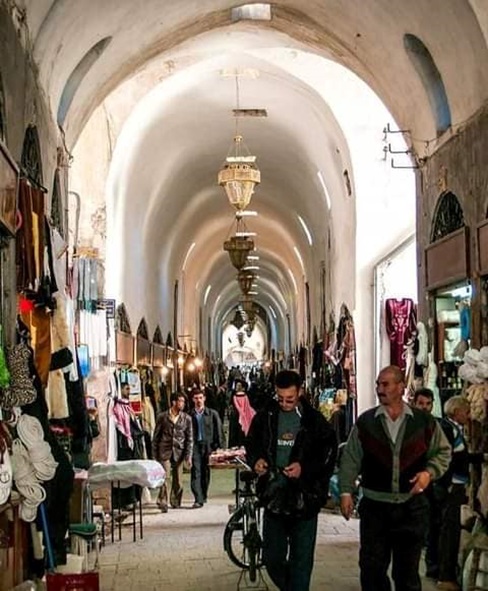The old markets of Homs are located on the outskirts of the city and not in the center, unlike those of major Syrian cities such as Damascus and Aleppo. This is due to the presence of the famous Al-Nuri Mosque at the outskirts of the city. These markets are of particular importance, as Syrians from every part in Syria have frequented them, due to the location of the city of Homs in the middle of Syrian cities and the fact that its markets remain authentic and extensive.
The beauty of their Islamic architecture distinguishes the ancient markets of Homs.They are covered by cylindrical ceilings, in addition to the so-called stone arches, which protect the visitor from the summer heat and winter cold and give the buildings a special spirit.
The vaulted stone arches, grand facades and graceful arches give a sense of prestige and an antique touch of history over the paved alleys, and under the shy sunlight of the few openings in the ceiling. Once two or more markets meet, a large dome rises, with squares that make the sun’s rays enter as small columns of light, illuminating the beautiful basalt land.
 The glamor of these markets was created by skilled manufacturers, traders and vendors, and was drawn by the eyes of incoming visitors to buy what they crave from traditional handicrafts. Market-goers used to find everything they wanted to buy there of all kinds of textiles such as brocade, damaskino, bags, gold jewelry, silverware, shoes, and perfumes.
The glamor of these markets was created by skilled manufacturers, traders and vendors, and was drawn by the eyes of incoming visitors to buy what they crave from traditional handicrafts. Market-goers used to find everything they wanted to buy there of all kinds of textiles such as brocade, damaskino, bags, gold jewelry, silverware, shoes, and perfumes.
Souk al-Nuri, or Souk al-Quafi, is probably the most famous old market of Homs. It is located next to the entrance to the al-Nuri Mosque, or the Nureddin al-Zinki Mosque. It was built in the period between 1743 and 1756, but some architectural renovations were added to it during the time of Pasha Abdel Hamid al-Droubi, as he made its floor of smooth paved stone. The old market was known in the past as the Al-Soulhufat Souk, “Turtle Market,” because of its turtle-like roof. It was famous for having many cafes, such as Zarabiya and Al Fakhoura, as well as the presence of a large number of shoemakers in it.
 Al-Bazrbashi market is an open market bordered to the east by the Bazarshi bath, and at the end of it there is a large square with a great number of shops that in turn connect to the old Ottoman Bath. In addition to its historical value, the Bazerbashi market is characterized by being crowded with visiting women, as it was called the Women’s Market, since everything women demanded was in it, and also because women sold old and used things there.
Al-Bazrbashi market is an open market bordered to the east by the Bazarshi bath, and at the end of it there is a large square with a great number of shops that in turn connect to the old Ottoman Bath. In addition to its historical value, the Bazerbashi market is characterized by being crowded with visiting women, as it was called the Women’s Market, since everything women demanded was in it, and also because women sold old and used things there.
The market of Al-Ma’sra was known by this name due to the old molasses press located in it, which is an archeological stone press. It was converted into a two-story textile and “novote” market. The upper roof of which was renovated in 1956.
There is also the “Textile and Industrial ” Market, which is one of the longest open markets, parallels the Bazerbashi market. As for Al-Qaysawiya market, it is another roofed market that also parallels the textile market and Khan Al-Qaysawiya.
Souk Al-M’rad is about 80 meters long, also called the perfume vendors’ market. It was distinguished by sculptures with decorative shapes, built in the Ottoman era. It is adjacent to the Silk Market, which is believed to be built in the Mamluk era, with a water fountain with mosaic-paved floor.
Souk al-Arab, which was built by the governor, Asaad Pasha, has become a place for the sale of fur and thread.
There is also the Al-Ubi market, or the Aga Khan Suwaidan market, in which one finds amazing Islamic architecture. During the days of the Great Syrian Revolution against the Ottoman occupation, it was a refuge for the revolutionaries and a place to run their operations, but now it contains many handicrafts’ shops such as upholstery, rugs, and cloaks.
As for the Caesarea Silk Market, “Souk Keisaryat Al-Hareer”, it was built by Asaad Pasha to be a place to receive visitors and pilgrims. Its name comes from a Greek word meaning huge royal building, or imperial building. It is characterized by a number of shops on the four sides, with a doorway that starts with a very large, wood-framed shutter in the middle of which there is what is called “Al-Khokha,” The Peach, which is a small door with a lock. It has a roofed lobby, leading to a stone staircase and then to the second floor, which contains 27 shops. It has a beautiful character, as the shops are surrounded by white columns with wooden ceilings.
The market contains traces of a stone press, which is believed to have been used for pressing olives, which made this market used for 100 years as a store for oil between 1800-1900, but then it returned into a market for the sale of various goods.
Amal Farhat

